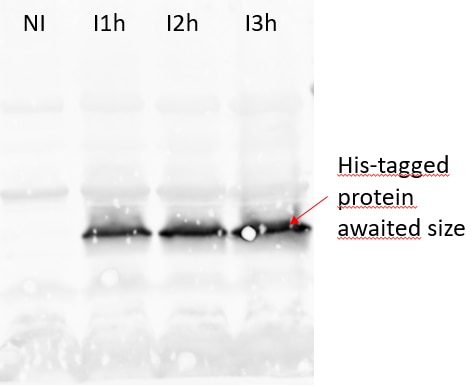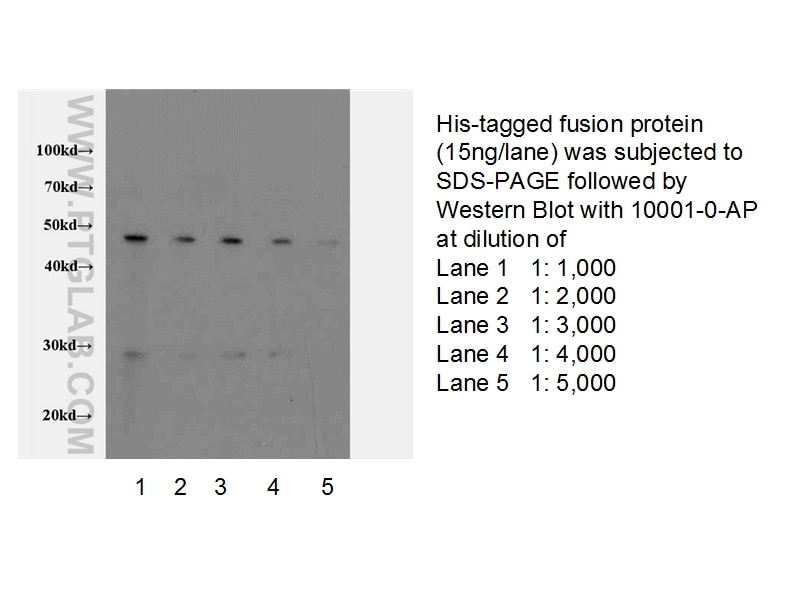"6*His, His-tag Antibodies" Comparison
View side-by-side comparison of 6*His, His-tag antibodies from other vendors to find the one that best suits your research needs.
Tested Applications
| Positive WB detected in | recombinant protein |
Recommended dilution
| Application | Dilution |
|---|---|
| Western Blot (WB) | WB : 1:500-1:2000 |
| It is recommended that this reagent should be titrated in each testing system to obtain optimal results. | |
| Sample-dependent, Check data in validation data gallery. | |
Published Applications
| WB | See 94 publications below |
| IHC | See 1 publications below |
| IF | See 10 publications below |
| IP | See 18 publications below |
| CoIP | See 3 publications below |
| ChIP | See 1 publications below |
Product Information
10001-0-AP targets 6*His, His-tag in WB, IHC, IF, IP, CoIP, ChIP, ELISA applications and shows reactivity with recombinant protein samples.
| Tested Reactivity | recombinant protein |
| Cited Reactivity | human, mouse |
| Host / Isotype | Rabbit / IgG |
| Class | Polyclonal |
| Type | Antibody |
| Immunogen |
Recombinant protein Predict reactive species |
| Full Name | 6*His, His-tag |
| Calculated Molecular Weight | 1 kDa |
| Gene Symbol | |
| Gene ID (NCBI) | |
| RRID | AB_11232228 |
| Conjugate | Unconjugated |
| Form | Liquid |
| Purification Method | Antigen affinity purification |
| UNIPROT ID | HISTAG |
| Storage Buffer | PBS with 0.02% sodium azide and 50% glycerol, pH 7.3. |
| Storage Conditions | Store at -20°C. Stable for one year after shipment. Aliquoting is unnecessary for -20oC storage. 20ul sizes contain 0.1% BSA. |
Background Information
Protein tags are protein or peptide sequences located either on the C- or N- terminal of the target protein, which facilitates one or several of the following characteristics: solubility, detection, purification, localization and expression. His tag is often used for affinity purification and binding assays. Expressed His-tagged proteins can be purified and detected easily because the string of histidine residues binds to several types of immobilized metal ions, including nickel, cobalt and copper, under specific buffer conditions. The antibody reacts to the 6*His tagged protein.
Protocols
| Product Specific Protocols | |
|---|---|
| WB protocol for 6*His, His-tag antibody 10001-0-AP | Download protocol |
| Standard Protocols | |
|---|---|
| Click here to view our Standard Protocols |
Publications
| Species | Application | Title |
|---|---|---|
Nat Commun USP52 acts as a deubiquitinase and promotes histone chaperone ASF1A stabilization. | ||
Cell Death Differ SLC15A3 plays a crucial role in pulmonary fibrosis by regulating macrophage oxidative stress | ||
Nat Commun Programmable probiotics modulate inflammation and gut microbiota for inflammatory bowel disease treatment after effective oral delivery. | ||
Nat Commun Regulation of energy homeostasis by the ubiquitin-independent REGγ proteasome. |
Reviews
The reviews below have been submitted by verified Proteintech customers who received an incentive for providing their feedback.
FH Brogan (Verified Customer) (11-09-2022) | Works very well, will buy again
|
FH Jean-Baptiste (Verified Customer) (04-21-2022) | Tested in Western blot for analysing the production in bacteria and the purification of a recombinant his-tagged protein. Worked quite well, with few unspecific bands.
 |






